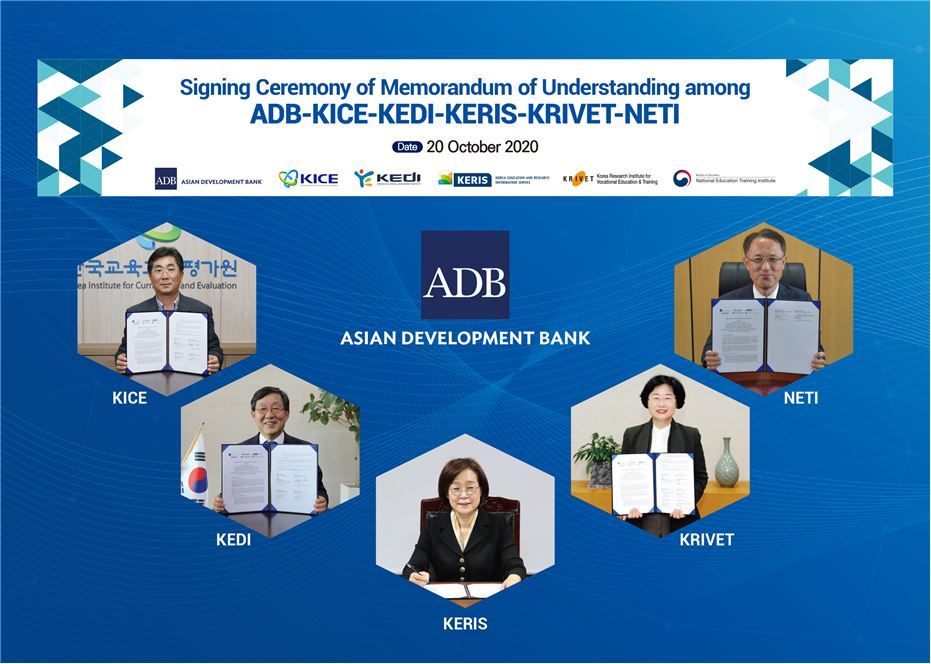Five South Korean agencies team up with ADB on education
By Ko Jun-taePublished : Oct. 20, 2020 - 16:35

Five South Korean educational institutions are partnering with the Asian Development Bank to improve the quality of education in the region.
They are the Korea Institute for Curriculum and Evaluation, the Korean Educational Development Institute, the Korea Education and Research Information Service, the Korea Research Institute for Vocational Education and Training, and the National Education Training Institute.
Under the memorandum of understanding signed Tuesday, the six parties will collaborate on baseline studies on improving the quality of education and come up with a comparative analysis of educational policies.
The parties will also work together to use information and communications technology for curriculum design, student assessment and teacher training, as well as to enhance online education and technical and vocational education and training programs in response to the COVID-19 pandemic.
The agreement will allow the institutions and the ADB to work jointly to assist the professional development of teachers and education officials. They will also carry out other joint projects such as international workshops.
The KICE said the MOU will help the involved parties to further promote collective action in responding to the COVID-19-induced educational crisis and develop educational development strategies for the future.
“I am delighted to sign the MOU with five prestigious educational institutions that have played transformational role in the Republic of Korea’s education system,” said Bambang Susantono, the ADB’s vice president for knowledge management and sustainable development, in a statement.
“These institutions bring expertise and experience in international development and will serve as strong partners for co-prosperity in Asia by contributing to education development in Asia and the Pacific Region.”
By Ko Jun-tae (ko.juntae@heraldcorp.com)
They are the Korea Institute for Curriculum and Evaluation, the Korean Educational Development Institute, the Korea Education and Research Information Service, the Korea Research Institute for Vocational Education and Training, and the National Education Training Institute.
Under the memorandum of understanding signed Tuesday, the six parties will collaborate on baseline studies on improving the quality of education and come up with a comparative analysis of educational policies.
The parties will also work together to use information and communications technology for curriculum design, student assessment and teacher training, as well as to enhance online education and technical and vocational education and training programs in response to the COVID-19 pandemic.
The agreement will allow the institutions and the ADB to work jointly to assist the professional development of teachers and education officials. They will also carry out other joint projects such as international workshops.
The KICE said the MOU will help the involved parties to further promote collective action in responding to the COVID-19-induced educational crisis and develop educational development strategies for the future.
“I am delighted to sign the MOU with five prestigious educational institutions that have played transformational role in the Republic of Korea’s education system,” said Bambang Susantono, the ADB’s vice president for knowledge management and sustainable development, in a statement.
“These institutions bring expertise and experience in international development and will serve as strong partners for co-prosperity in Asia by contributing to education development in Asia and the Pacific Region.”
By Ko Jun-tae (ko.juntae@heraldcorp.com)

















![[KH Explains] Hyundai's full hybrid edge to pay off amid slow transition to pure EVs](http://res.heraldm.com/phpwas/restmb_idxmake.php?idx=652&simg=/content/image/2024/04/18/20240418050645_0.jpg&u=20240418181020)

![[Today’s K-pop] Zico drops snippet of collaboration with Jennie](http://res.heraldm.com/phpwas/restmb_idxmake.php?idx=642&simg=/content/image/2024/04/18/20240418050702_0.jpg&u=)